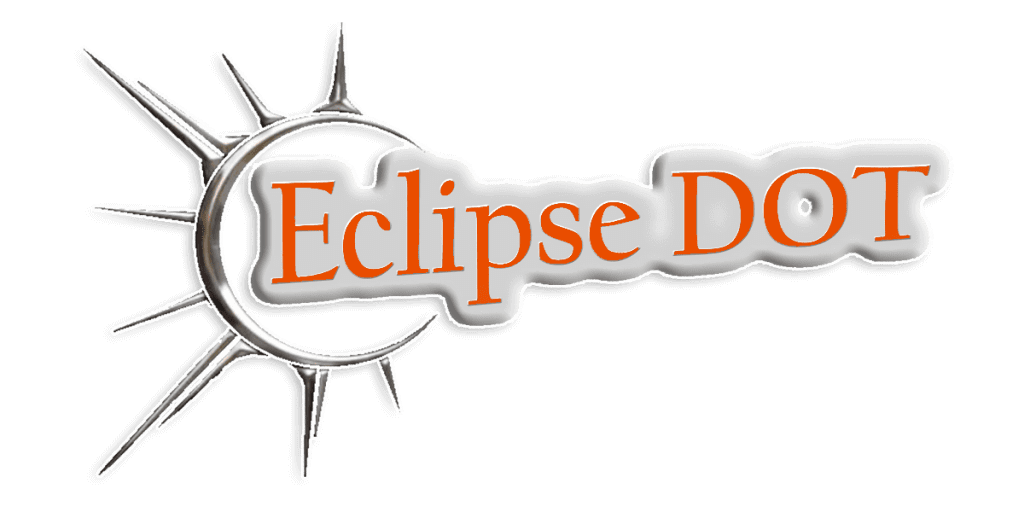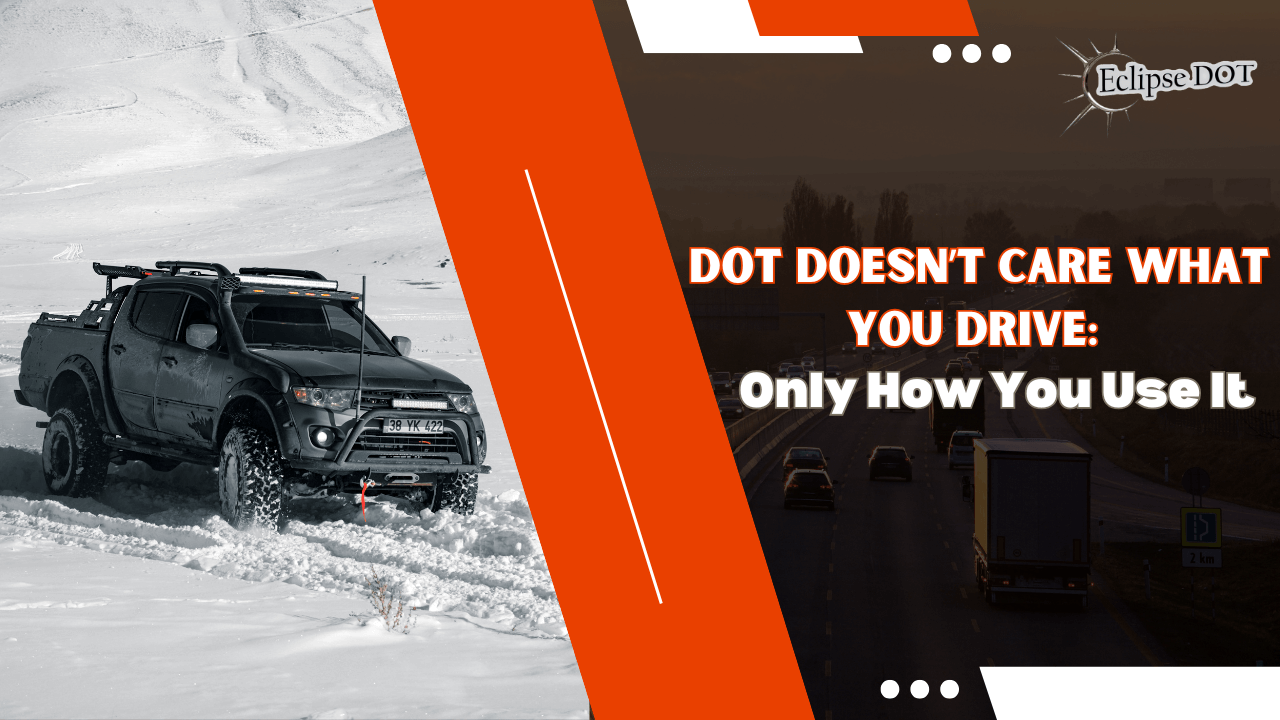By Eclipse DOT News – Educating business owners, one fine at a time
At Eclipse DOT, we’ve heard every excuse under the sun.
“It’s just a pickup.”
“We’re not a trucking company.”
“We only haul our own stuff.”
“We stay in-state. That stuff doesn’t apply to us.”
The first time someone says it, we smile and nod. The third time? We know what’s coming next: a phone call, some panic in the voice, and a big fat citation from the Department of Transportation.
And it all starts because someone assumed that the vehicle they were driving didn’t count.
But the DOT?
It doesn’t care what you drive. It only cares what you’re doing with it.
And if that pickup, trailer, or combo setup crosses the 10,001 lb weight threshold while being used for business, it qualifies as a Commercial Motor Vehicle—whether you knew it or not.
That’s when things get real.
When “Just a Pickup” Costs $7,900
We got a call not long ago from a company that had been doing business the same way for years. No CDL trucks, no for-hire freight, no interstate runs. Just a pickup, a trailer, and a few hardworking guys moving equipment between job sites.
They’d never had a problem before. But then they got pulled over.
The officer did what officers do—he checked their GVWR. The truck was rated for 10,000 lbs. The trailer? Another 7,000 lbs. Total: 17,000 lbs combined.
That put them squarely in DOT-regulated territory.
But they didn’t have a DOT number.
They didn’t have driver qualification files.
They weren’t enrolled in a drug and alcohol testing program.
And they didn’t even know what a maintenance file was.
They weren’t trying to cut corners—they genuinely didn’t know.
The result? A citation totaling $7,900, issued on the spot.
That’s how fast “just a pickup” turns into a DOT violation. Not because they were hauling for hire. Not because they were driving recklessly. But because the weight and purpose of the vehicle matched DOT’s definition of a commercial motor vehicle.
They weren’t trying to be noncompliant.
But ignorance doesn’t get you a pass.
So What Counts as a Commercial Motor Vehicle?
Here’s where it trips people up.
Most folks hear “Commercial Motor Vehicle” and picture a big rig rolling down the interstate. They imagine 18-wheelers, CDL drivers, weigh stations, and long-haul freight.
What they don’t realize is that the DOT’s definition is a lot broader than that.
If your vehicle—or vehicle and trailer combined—has a Gross Vehicle Weight Rating (GVWR) or Gross Combined Weight Rating (GCWR) of 10,001 pounds or more, and it’s used in commerce (that means business, not personal use), you’re now operating a CMV in the eyes of the law.
That means all the rules that apply to those “real trucking companies”?
They now apply to you, too.
Whether you’re hauling materials for a fence job, moving pipe to a drilling site, or towing a mini-excavator to the next project, if you’re using that truck and trailer to support your business, the DOT is interested. And they’re not known for casual conversations.
Why This Catches So Many Companies Off Guard
The biggest reason people get fined isn’t willful neglect—it’s confusion.
Most businesses that get caught in this trap genuinely don’t think DOT regulations apply to them. And why would they? They don’t have big trucks. They’re not hauling across the country. They’re not “trucking.”
But the law doesn’t care about the logo on the door. It only looks at the weight and purpose of the vehicle.
This is especially common with:
-
Oil & gas contractors running F-350s and goosenecks
-
Utility companies using pickups and trailers
-
Construction crews moving materials and equipment
-
Landscapers hauling mowers and skid steers
-
Municipalities using light-duty vehicles for field work
All of these can fall under DOT oversight—not because of the vehicle itself, but because of how it’s being used.
The Cost of Not Knowing
What’s at stake if you get it wrong?
It’s not just about one fine or one ticket. It’s the chain reaction that comes after:
-
Fines from $500 to $15,000 per violation
-
Vehicles placed out of service until you fix it
-
DOT audits triggered by a single inspection
-
Higher insurance rates—or policy cancellations
-
Lawsuits if an accident happens and you weren’t in compliance
-
Lost contracts because your safety rating tanks
One small oversight today can blow up into a major liability tomorrow.
We’ve seen companies lose job bids after a compliance issue. We’ve seen field crews parked for days while paperwork gets sorted out. And we’ve had panicked calls from safety managers who didn’t even know what they were supposed to be tracking.
They all say the same thing:
“We didn’t know this applied to us.”
And every time, we say:
“That’s why we’re here.”
So What Do You Do About It?
You don’t need to panic. You just need to get proactive.
Start by asking the right questions:
-
What are my vehicle and trailer GVWRs?
-
Are we using this setup for business purposes?
-
Do we cross 10,001 lbs combined weight?
-
Have we registered for a DOT number?
-
Are we maintaining driver files, maintenance logs, and drug/alcohol compliance?
If you’re not sure how to answer those questions, you’re not alone. That’s where we come in.
At Eclipse DOT, we make this easy. We’ve built systems like DOT Docs and the Effortless Compliance Framework so regular companies—construction crews, oilfield teams, city departments, and more—can stay compliant without hiring an entire department or turning into legal scholars.
We’ll review your setup.
We’ll show you exactly what’s required.
And we’ll walk with you every step of the way until you’ve got a system you can rely on.
You Don’t Need a CDL to Be Regulated
This is another place people get tripped up. They assume that if their drivers don’t need a CDL, they’re in the clear.
That’s false.
You can be well under the CDL threshold of 26,001 pounds and still be 100% DOT-regulated. In fact, most of the companies we help fall into that category—vehicles between 10,001 and 26,000 pounds doing regular business across job sites.
These setups don’t require a CDL, but they do require:
-
DOT numbers
-
Driver files
-
Maintenance tracking
-
Hours of service rules (sometimes)
-
Drug & alcohol compliance (yes, even in pickups)
It’s not about the driver’s license. It’s about liability and regulation.
The sooner you acknowledge that, the sooner you can fix it.
This Isn’t About Fear—It’s About Leadership
At the end of the day, this isn’t a scare tactic. It’s a leadership call.
Great companies don’t operate in the dark. They don’t wait for fines or lawsuits to tell them how the rules work. They take ownership, build systems, and protect what matters: their team, their reputation, and their ability to grow.
That’s why Eclipse DOT exists.
We’re here to make the hard stuff easier.
To teach without talking down.
To help blue-collar businesses operate like pros.
So if you’re still hanging on to the phrase, “It’s just a pickup…”
We love you, but it’s time to let that go.
Because the DOT doesn’t care what you drive.
Only how you use it.
Gain exclusive access to our CDL & DOT Compliance articles with a trial at DOTDocs.com. And don’t forget to claim your FREE micro audit at THE ECLIPSE DOT MICRO AUDIT. Ready for seamless operations? Discover the difference today!


